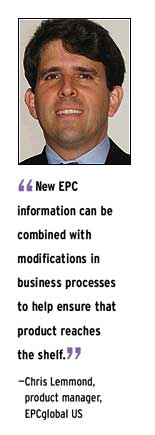Jan 16, 2005By Mark Roberti
Now that the EPC is being adopted by leading retailers in the United States and Europe and by the U.S. Department of Defense, collaboration has become critical. Many of the big benefits EPC offers—cutting out-of-stocks, slashing inventory throughout the supply chain, reducing counterfeiting, and automating shipping and receiving—can be achieved only if companies work together, share data and develop standardized business processes. But there are obstacles to collaboration, including competing corporate agendas, competitive issues and cultural inhibitions about sharing information. The companies that overcome them will likely benefit most from EPC technology.
“You can optimize your operation within your own four walls and achieve some efficiencies, but collaboration is the key to getting some of the bigger benefits that EPC promises,” says Bob Mytkowicz, manager of customer, order, and logistics systems for Gillette in North America.
By far the biggest benefit for both retailers and manufacturers is reducing the number of times a product is not on the shelf when a customer comes in to buy it. Linda Dillman, Wal-Mart’s CIO, says knowing what’s in the back of the store is the single most important type of information her company will get from RFID, because it will help Wal-Mart reduce out-of-stocks.
But retailers and suppliers need to work together to reduce out-of-stocks. “New EPC information, even from reading pallet and case movement and location, can be combined with modifications in business processes to help ensure that product is visible, traceable and reaches the shelf,” says Chris Lemmond, product manager for EPCglobal US. “And that’s the goal for both manufacturer and retailer.”
To improve replenishment, manufacturers need more timely information about demand at a store and the level of inventory within the store. “The worst-case scenario is when we get inventory records that show that inventory is on hand at the store, but the point-of-sale data shows no sales,” says Gillette’s Mytkowicz. “Why isn’t it selling if it’s there? The inventory information is wrong. If we could scan inventory and know that even though the retailer’s records show it has 12 cases, they’re really not there, then we can replenish and deal with that problem.”
But what information does a retailer need to supply to the manufacturer? How often does the retailer need to supply it? What processes must the retailer and manufacturer revise in order to take advantage of the new information that the manufacturer gets?
The only way to get the answers to these questions is for manufacturers and retailers to work together to map out how systems might change and then to run a pilot to prove the concept. Sean Campbell, a partner with IBM Business Consulting Services, says supply chain partners can begin this work before actually deploying RFID tags and readers by sharing data collected from bar codes.
“If retailers share existing data, manufacturers can use it to begin to change their replenishment processes,” he says. “The partners can work together to see if the manufacturer can use the retailer’s store-level data to better align its production with demand.”
“The key to reducing inventory is for the retailer to provide demand signals in a more timely way,” he says. “How often do you need the signals? It won’t be the same for every category or product type, because some products aren’t subject to the kinds of spurts in demand that require large safety stocks.”
Pilots can help both retailers and manufacturers understand how EPC data can be used to reduce safety stocks. Third-party logistics providers might also need to be involved with pilots, because some manufacturers and retailers envision using their logistics provider’s trucks as mobile warehouses. “Instead of holding stock in their own warehouses, they’re looking at product in transit as a buffer,” says Jonathan Loretto, global technology lead for RFID at Capgemini, the global IT services firm. “We’re moving toward much more dynamic supply and replenishment systems.”
Shipping and Receiving
For both suppliers and retailers, the proverbial low-hanging fruit is the use of RFID to automate shipping and receiving. If the supplier scans a pallet to ensure that every case on it matches the retailer’s purchase order and sends the EPCs to the retailer in an advance shipment notice (ASN), the retailer can scan the goods when they arrive at a distribution center or the back of a store. If the EPCs match those in the ASN, the retailer knows it got what it ordered and the supplier can issue an invoice for the goods.
Such a system can reduce the time and labor it takes for a manufacturer to investigate invoice deductions for goods the retailer says it didn’t receive. The retailer can also save time and money by not expending labor to count boxes or scan bar codes when goods arrive. But the retailer and supplier must agree on procedures for sharing data and on what constitutes proof of delivery. “Achieving the efficiencies has a lot to do with working together,” says Abell.
A potential problem for manufacturers is that different retailers could establish different procedures and systems for sharing data, providing proof of delivery and so on. It would be far more efficient for industries to establish procedures that all companies will use. Gillette’s Mytkowicz and Procter & Gamble’s John Duker are cochairing an EPCglobal working group that is exploring procedures for using EPC technology to automate shipping and receiving. “We’re trying to articulate the foundations that will enable the technical and software people to define the standard components necessary to effect that,” says Mytkowicz.
Many industries, such as pharmaceuticals, auto and airplane parts, and apparel, have a problem with counterfeit goods. The solution being pursued by a group of early adopters in the drug industry is to create an “electronic pedigree”—a secure record documenting that a drug was manufactured and distributed under safe and secure conditions.
The aim is to put a unique serial number on a product when it’s made, and use that number to track the product’s every movement through the supply chain. That way, if drugs are stolen and sold through another channel, a manufacturer could trace back and find the last person who handled the shipment before it disappeared. The system would also prevent a pharmacy from unknowingly selling drugs that are counterfeit, because the pharmacy could match each shipment against serial numbers provided by the wholesaler or manufacturer.
Once procedures are established, they must be agreed upon by a critical mass of players within the supply chain; otherwise different groups of manufacturers, distributors and retailers will adopt different procedures and different IT systems, which creates inefficiency. One way to avoid that problem is to share information through trade organizations. The Healthcare Distribution Management Association, which represents drug distributors, and the National Association of Chain Drug Stores, which represents pharmacies, are members of the Jumpstart Group. Both organizations are disseminating information within the pharmaceutical industry to ensure that one set of procedures for creating an electronic pedigree is adopted industry-wide.
Barriers to Collaboration
The benefits of collaboration are significant to all companies in the supply chain. But collaborating is never easy. Companies have divergent agendas, financial interests and competitive issues. Even if manufacturers, distributors and retailers join forces, each may want to focus on a different supply chain problem, because the business case for using RFID technology is different for each of them.
Some companies are working around that issue by collaborating one-on-one with supply chain partners, while also working on industry standards through trade groups and standards-setting bodies. Kimberly-Clark is an example of a company that’s executing this strategy successfully. The Irving, Texas–based maker of paper, household and personal care products is among the first eight suppliers to send tagged pallets and cases to a Wal-Mart distribution center in Texas.
Mike O’Shea, Kimberly-Clark’s director of corporate Auto-ID/RFID strategies and technology, is cochair of EPCglobal’s Business Action Group, which is defining user requirements for the second-generation UHF EPC protocol. “We’re working through EPCglobal to establish standards for exchanging data for shipping and receiving and track-and-trace,” says O’Shea. “But when it comes to proving the business case for EPC, we’re working with our partners one-on-one.”
In addition to working with its retail partners, Kimberly-Clark recently began discussions with some of its packaging suppliers. The goal is to put EPC tags inside corrugated boxes before they are shipped to Kimberly-Clark’s manufacturing facility. That would allow Kimberly-Clark to write an EPC number to the tag when a box is filled with product. Kimberly-Clark, in turn, would share information about when the boxes are used to determine how its packaging suppliers could benefit from using EPC technology. “If we don’t have sharing of data between supply chain partners,” says O’Shea, “we won’t get the benefits.”
Kimberly-Clark created an IT architecture for sharing data with its suppliers on one end and its retail partners on the other (retail partners, such as Wal-Mart, also provide information back to Kimberly-Clark through point-to-point connections). For now, Kimberly-Clark will maintain the databases of information about its products and their movements on its own computer systems and provide access to its supply chain partners. O’Shea envisions that once the EPC Network is fully functional, it should be easy to switch to sharing data over the network.
Over the next 12 to 18 months, companies in every industry—regardless of whether they are facing RFID mandates—should take the initiative to collaborate. Small-scale pilots can help them figure out what data they need to share with supply chain partners and what business processes they need to change to take advantage of the new data EPC technology will provide. At the same time, companies should join trade associations and EPCglobal to ensure that data formats and common business processes are adopted across their industry. The challenges are great, but the payoff for successful cross-supply-chain collaboration could be huge.



